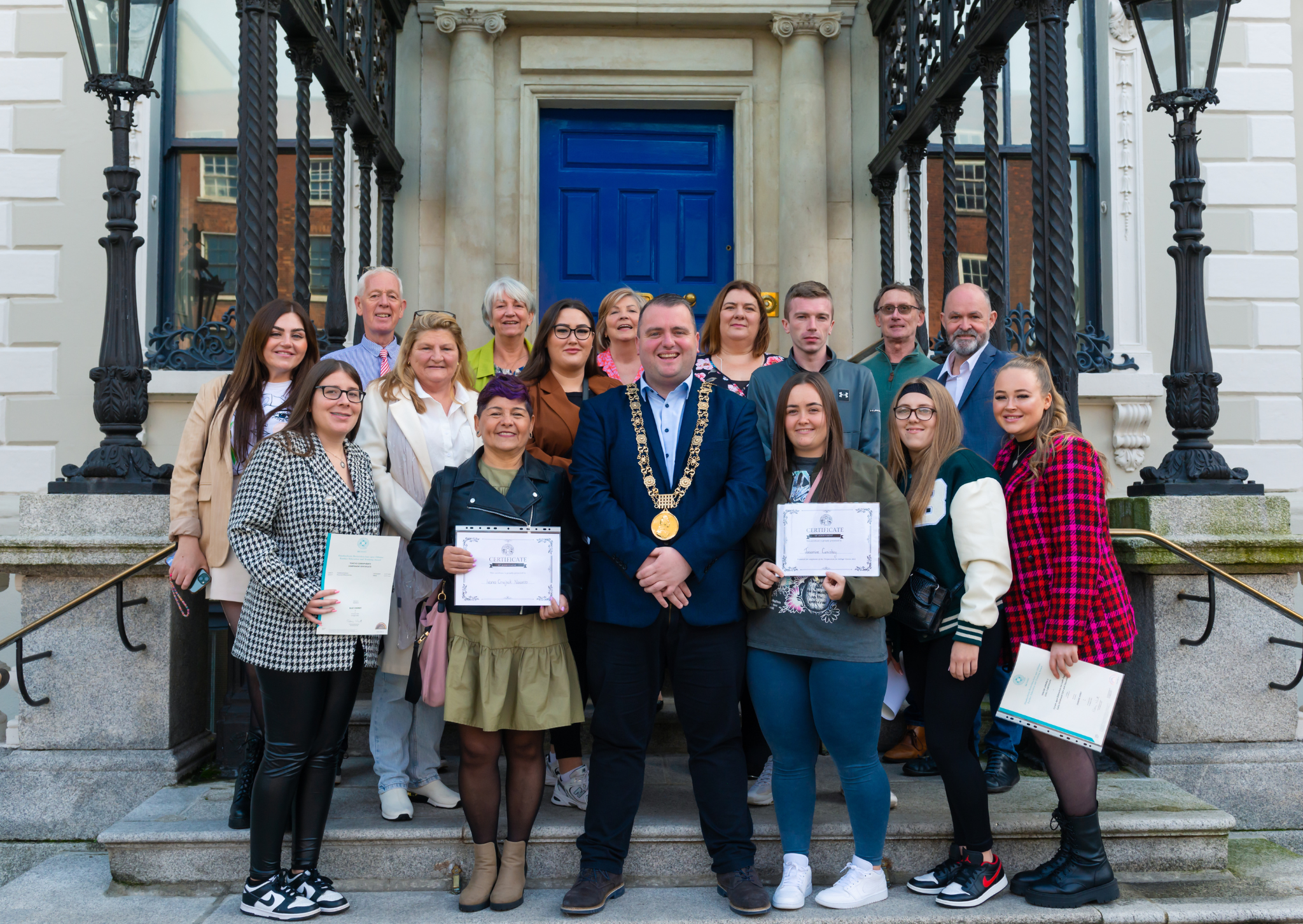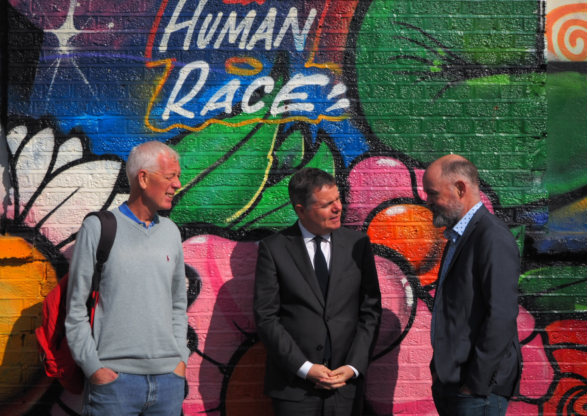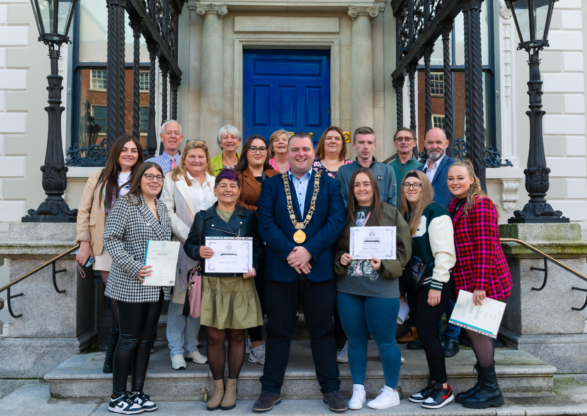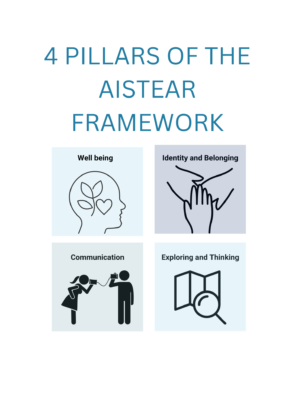
Dr Tom O Brien
Dr Tom O Brien is the Manager of Community After Schools Project (CASPr) based in the North East Inner City. Tom was awarded his PhD from Maynooth University in addiction treatment in young people in 2004
INTRODUCTION AND CONTEXT
I am an adult and community educator working in the North-East Inner-City (NEIC). In this article I will explore some of the challenges and opportunities facing this community in the context of my work as
manager of the Community After Schools Project (CASPr).
The NEIC of Dublin has a rich and complex history, marked by various social, economic, and cultural changes over the centuries. The NEIC was once the home to many of Dublin’s political and social elites, many of whom lived in the elegant Georgian houses that surrounded Mountjoy Square, Gardiner St and Gloucester St. The Act of Union (1801) unintentionally transformed the area, as the elites vacated Dublin for London, leaving behind what became Tenement Dublin and some of the worst slums in Europe. This
transformation was intensified by the Great Famine, which drove starving people from the West of Ireland to Dublin’s North Inner City. Both of these events transformed this part of Dublin from a place for the rich and powerful, to a place for the poor and dispossessed. Tenement Dublin became synonymous with overcrowding, unsanitary living conditions and widespread poverty and disease.1
In Tenement Dublin, the Docks was the main source of employment, until container shipping replaced manual labour and the NEIC was hit by the problems of high unemployment and alcoholism, Ireland’s first drug problem. Drug problems usually require the fertile soil of human suffering to take root. Drugs provide people with a way to manage the suffering associated with alienation2 and a lack of recognition.3 Karl Marx theorised how the working class become cut off from themselves as they are forced to serve the interests of the elite classes. In the words of Jim Larkin, ‘The great appear great, because we are on our knees. Let us rise’.4 Later the German Political Philosopher, Axel Honneth, saw humans in a struggle for recognition on three levels: legal, social, and relational. When these fundamental needs are not met, we experience what he calls ‘disrespect’. Poverty, exclusion, racism, sexism or unemployment are forms of disrespect. The continued alienation and disrespect experienced by people of the NEIC in the eighties and nineties, opened the door to a new and more deadly drug problem, one associated with heroin, a drug problem that continues to inflict enormous suffering on the North-East Inner-City today. Both Marx and Honneth would argue that heroin users are in a struggle
for recognition and search to overcome their sense of alienation.
The most recent history of the NEIC has been reshaped by new social, cultural and economic changes. The growth of the financial services centre or ‘IFSC’ has seen an enormous increase of wealth being traded and exchanged within the NEIC. New apartment blocks and gated communities are rising up to
create a new skyline alongside the local and historical communities, many of whom feel left behind. These changes are taking place against the backdrop of years of austerity in response to the economic collapse that stripped this community of many vital services and supports. Despite being one of the richest countries in the world (at least on paper), the government is unable to provide housing to everyone who needs a safe and secure place to live. This is not surprising since the housing crisis can be traced to a legacy of political corruption and the fallacy that the market will deliver housing for all.
Finally, there is the rise in immigration and our inability to provide accommodation to asylum seekers and refugees, many of them living on Gardiner St. It seems the poor, dispossessed and powerless are the last to have their voice heard and their needs met in a neoliberal world that values profits over humans. The rising tide has not lifted all boats equally within the NEIC and in that vacuum the community has always organised itself to fight for all humans of the NEIC, equally and fairly.
RETURNING TO THE NORTH-EAST INNER-CITY
In the early nineties, I found myself living in an iconic building, the convent on Sean McDermott St., the location to a Magdalene Laundry. The Laundry was still operating at that time, and I got to know some of the women unjustly incarcerated there. The Magdalene Laundry was one of many Irish institutions that worked on behalf of the State to cleanse the unwanted, rebellious, delinquent or insane.5
At the time I was a member of a new Salesian Community that established a presence on Sean McDermott St. in 1992. The Salesians were an Italian religious order founded by Don Bosco, whose mission was to work with young people on the edges of society. The drug problem was emerging at the time and we were in a position to partner with the community to establish the Crinan Youth Project, a
specialised service for young people dependent on substances. I left the Salesian community in 1999, but returned to Sean McDermott St. to complete my PhD research on medical power and addiction treatment for young people.6
Paula was the first teenager I knew who used heroin. Drug use became her way to distract, soothe, and comfort herself, from the pains of her life, until one day there was no more pain and she was gone. She became a statistic in the failed war on drugs that continues to be waged on the streets of the NEIC today.
THE COMMUNITY AFTER SCHOOLS PROJECT
Having managed addiction services for many years, I now find myself managing a service with a focus on children from the NEIC. I quickly realised these children are the sponges of the trauma that addiction spreads from one generation to the next. Early intervention in their lives, through transformative experiences may nudge them towards a safer pathway.
The Community After Schools Project (CASPr) is a community based organisation that aims to provide educational support to children, parents and other adults in order to tackle educational inequality in the NEIC. Our children’s services include a créche in Sean McDermott St. for 15 children and two after school projects catering for 70 children daily. We have a long waiting list for both after school projects. There are an estimated 1,800 primary school children in the NEIC and only a fraction of those have access to after school programmes. The adult education service offers courses in Early Years Education,
Learning to Learn and English for speakers of other languages (ESOL). Our new adult and community education strategy aims to provide new services to parents in the form of one to one support and advocacy, as well as workshops and short courses.
At the heart of CASPr is a group of staff and voluntary board members deeply committed to educational equality and services for children from the NEIC. CASPr was established in 1995 during a period of organic blossoming of community projects in the NEIC, supported by a powerful network of people under the umbrella of the Inner City Organisations Network (ICON), led by Fergus McCabe and many others. The drug problem was deepening, people were dying and there was a fear associated with increased crime and the spread of HIV through intravenous drug use. So the government invested in the community infrastructure and services for children, youth, addiction, education, and community. However, since austerity measures were introduced, funding remains insecure on an annual basis and insufficient to meet the needs of this community.
While mainstream services like schools, hospitals, and social work do excellent work, many people fall through the net. In the NEIC community services have always evolved and responded to catch those falling through the net and provide local spaces to connect with people. The NEIC has a long history of
community development connecting people to each other and to a local infrastructure that they come to depend on.
CONNECTION IS KEY
I am in primary school. It’s 1979 and my teacher, Mr. Sherlock, notices me staring out the classroom window. ‘Would you like to go outside and have a closer look?’ he asked. ‘Yes, Sir, I would’. I replied. So, I proceeded to leave the classroom and then the school building to make my way up to the horizon where the football pitch was situated. I sat there looking back down on the school that had now shrunk in size. When the bell rang, I returned to class, and never remember looking out the window again. Mr. Sherlock had connected with me, with empathy, compassion, and respect. Looking out the window for me was a self-soothing ritual, to avoid the stress of having to concentrate as well as the need to avoid how
I was feeling. Our primary need is to connect with each other.
Sometimes just being a child can be traumatic, but if you live in the NEIC, that trauma is multiplied as children risk being exposed to violence, death, abuse, neglect, hunger, and exploitation. Trauma is then played out through various behaviours in school, at home and on the street.7 Too many young people
get sucked into drugs as their preferred way to manage the fear that lies at the heart of how they are feeling. Many young people fall between the cracks as they try to navigate the transition into secondary school. Local Youth Services like the SWAN, Crinan or LYCS have played a vital role in keeping many of
these young people connected.
My transition to secondary school was a rough one, that involved a lot of ‘mitching’ from school, and hiding in pool halls and handball allies. I was sixteen when I sat and failed my leaving certificate. Labelled a school failure, ‘educationally disadvantaged’, I wasn’t bothered because I didn’t have many
didactic experiences of education, except for the one constructed by Mr. Sherlock. Education didn’t make much sense to me, as it didn’t connect with my world in any real and meaningful way. This is the experience of many thousands of young people who are classified as ‘educationally disadvantaged’, for leaving school early or for failing their Leaving Certificate.
Though I left school at 16, with only 4 passes in my leaving certificate, I had completed a PhD by the age of 36. Schools do great work and play an important role in our lives but for many it’s a painful experience. I was fortunate to find my passion and return to education as an adult. However, many remain scared by their experience in school and remain educationally disadvantaged throughout their
lives.
Educational disadvantage is a way to describe the systematic fractures in our educational system that allows too many to fall through the cracks and leave school early. Most of the research suggests that remaining in school increases your chances of going to further and higher education, securing higher paid employment and sustaining better health for longer.
Education is key, but it must unlock access for everyone equally. Where you are born and your parents’ employment history will significantly influence your chances of staying in school and doing well or not. If you are born in the NEIC your chances of doing well in education or employment are already negatively impacted.
A lot is being done in schools to reduce educational disadvantage, but unless we address the systemic inequalities in our neoliberal society, little will change at the macro level. Too often we seek to address systemic failures, by covering the cracks and silencing those who speak up and out against the failings of
our state. The education system itself is a legacy from the industrial revolution, that aims to produce a compliant workforce, for the owners, controllers and political elite who benefit from structural inequality.
The popular idea of formal education and raising educational outcomes as a way out of disadvantage is not true.8 It is more challenging for disadvantaged children to engage in education and achieve curriculum outcomes compared to their better off peers. The hidden curriculum with its unwritten
rules and expectations of the dominant culture, makes it more difficult for children from disadvantaged communities to thrive in school. Schools provide an advantage to those already advantaged by their cultural capital and established security as beneficiaries of the status quo.
The Brazilian philosopher of education, Paolo Freire also outlined how schools are not places of social liberation but centres for what he called ‘banking education’ that act to maintain the status quo and place
of marginalised groups.9 Giroux10 calls for educators to connect the classroom knowledge to the experiences, histories and social worlds of students, making learning more immersive and relevant. To my delight some of these concepts are making their way into the Early Years Education curriculum.11
PEDAGOGY BEYOND THE CLASSROOM
New to the childcare sector when I arrived at CASPr, I was excited to realise that the term ‘Early Years Educators’ had replaced the traditional term ‘Childcare Workers’ acknowledging the evolution of the sector. Our staff are educators, not childminders. I was also excited to realise that at the heart of CASPr was a pedagogical approach. CASPr draws inspiration from Freire’s work within our adult and community education service, within the limitations of the systems that fund our programmes. He argues for a different type of pedagogy, one based on dialogue rather than monologue.12 Supporting our staff to think critically and reflectively prepares them to engage children in the same process. Why
should children have to accept the assumptions of the world they inherit? CASPr works to nurture their imagination, inspire their creativity and protect their hope. Providing children with transformative experiences can influence the direction they take in life.
CASPr’s pedagogical approach is framed within ‘Aistear and Siolta’. Aistear is the Early Childhood Curriculum Framework (2009a) and Síolta, is the National Quality Framework for Early Childhood Education (2006) both of which are used together within CASPr to develop a high quality curriculum that supports the children’s learning and development.
CASPr prioritises the formation of nurturing relationships, that are trauma informed and child centred. The work of Stephen Bavolek13 reflects the essence of what CASPr is trying to achieve, i.e., nurturing emotional relationships. Many children who attend our services are exposed to community violence,
fragile family structures and inconsistent nurturing, leaving them traumatised and hurt. Empathy and the development of secure relationships is at the heart of the work of CASPr. Keeping them safe and
secure is important of course, nurturing them with engaging and fun activities makes the experience enjoyable, but making the children feel loved, special and unique is where we focus most of our attention.
The After Schools Project provides an important mental and emotional break from school, which is by design more competitive and demanding. Having fun in a less structured environment in turn makes
the school experience less stressful, knowing that is only part of their day. In this way CASPr acknowledges that the children exist, according to Urie Bronfenbrenner, within a series of systems he calls Ecological Systems, the child being the microsystem, situated within family, community, cultural, economic and political systems.14 As the children who attend our service are from different ethnic
and cultural backgrounds, this awareness supports the child to understand that life is not black and white, but layered beautifully as each child is unique and different. Each child can be a teacher for the next, each learning from the other and so on. The world is a better place with children that feel safe, nurtured and who are flourishing.
CONCLUSION
A lot has changed since CASPr was established in 1995. Today we face old and new challenges. We have an ongoing major drugs problem in the NEIC, with significant annual drug related deaths, progression routes to prison rather than university, the rise in territorial gang violence, the economic crash, austerity, homelessness, a rise in immigration, Covid and the Dublin riots. These are issues that affect the population the length and breadth of Ireland, but are particularly concentrated in the NEIC for historical and cultural reasons.
The Early Years Education sector has also been transformed during the same period with multiple support agencies and funders now involved, along with significant regulations with oversight from TUSLA inspectorate and compliance obligations under the Charity Regulatory Authority. However, there are significant challenges recruiting Early Years Educators and their pay and conditions do not reflect the value of their work and the important role they play in society.
The NEIC is a better place because of the community organisations like CASPr and the work they do for and on behalf of the citizens. The State is not able to solve these problems alone. The most effective and sustainable solutions are born out of trusting relationships between the state, civil society and the people. There is a need to restore trust in each other and work together to make the NEIC a just
and equal community for everyone. This will require investment in anti-poverty approaches, built on participatory democracy and a shift away from neoliberal practices. CASPr plays a small role in that process and will continue to fight for and to advocate for the children of the NEIC.
Footnotes:
1 Kevin Corrigan Kearns, Dublin Tenement Life. (Dublin: Gill, 1996)
2 Gajo Petrovic, “Marx’s Theory of Alienation,” Philosophy and Phenomenological Research, Vol. 23, No. 3 (1963): pp. 419-426.
3 Axel Honneth, The Struggle for Recognition. (Oxfoard: Oxford Press, 1996)
4 Rory McConville and Paddy Lynch, Big Jim: Jim Larkin and the 1913 Lockout (Dublin: O’Brien Press, 2013), 82.
5 Mark Coen, Katherine O’Donnell, and Maeve O’Rourke, A Dublin Magdalene Laundry: Donnybrook and Church-State Power in Ireland (London: Bloomsbury Academic, 2023)
6 Tom O’Brien, “Discourses in Drug Treatment. Exploring the meaning of drug treatment in the Crinan Youth Project”. (PhD Thesis. Maynooth University, 2004)
7 Dalma Fabian, “Lifelong Harm of Trauma and Homelessness,” Working Notes 32, no. 83 (2019): 4–10.
8 Michael Grenfell, Pierre Bourdieu: Key Concepts (Durham: Acumen, 2008)
9 Paulo Freire, aPedagogy of the Oppressed (London: Penguin Random House, 1970)
10 Henry Giroux, On Critical Pedagogy (London: Continuum Publishing, 2011)
11 “Aistear and Siolta Practice Guide,” Aistear and Siolta, accessed online 2nd April 2024,. https://www.aistearsiolta.ie/en/introduction/
12 Freire, Pedagogy of the Oppressed.
13 Steven Bavolek & Fran Kaplan, Nurturing Parenting Programs. Program Implementation Manual and Resource Guide (Asheville, NC & Park City, UT: Family Development Resources, 2007)
14 Urie Bronfenbrenner, “Towards an experimental ecology of human development,” American Psychologist 32, no 7(1977): 513-531.




